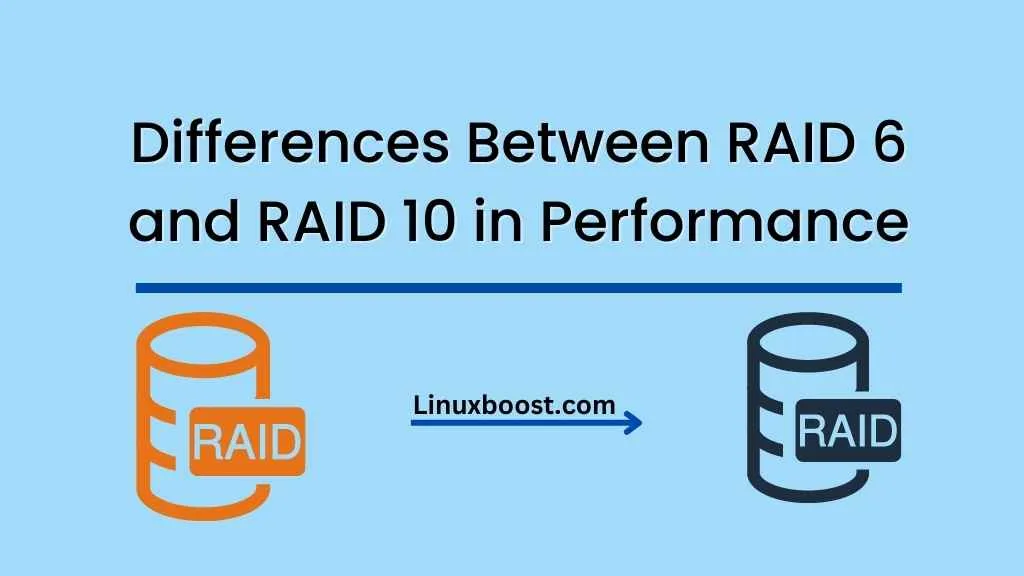When it comes to data storage and protection, RAID (Redundant Array of Independent Disks) configurations play a critical role. Two popular RAID levels that offer robust data protection are RAID 6 and RAID 10. This article will explore the key differences between RAID 6 and RAID 10 in terms of performance and use cases. We will also provide useful resources for setting up RAID on different Linux distributions.
RAID-6: Double Parity
RAID 6 is an extension of RAID 5 and uses double parity, meaning it can tolerate the failure of two disks simultaneously. This configuration stripes data across multiple drives and stores two parity blocks on separate drives for each data block.
RAID 6 Performance
- Read Performance: RAID 6 provides excellent read performance, similar to RAID 5. However, due to the overhead of managing the extra parity block, it is slightly slower than RAID 5.
- Write Performance: RAID 6 suffers from reduced write performance, as it needs to write two parity blocks for every data block. This results in slower write speeds compared to RAID 5.
- Fault Tolerance: RAID 6 offers higher fault tolerance than RAID 5, as it can handle the failure of two drives.
RAID-10: Mirrored Stripes
RAID 10, also known as RAID 1+0, is a combination of RAID 1 and RAID 0. It involves striping (RAID 0) data across multiple drives and mirroring (RAID 1) the stripes for redundancy.
RAID 10 Performance
- Read Performance: RAID 10 provides excellent read performance, as it can read data from both mirrored sets simultaneously. This results in faster read speeds compared to RAID 6.
- Write Performance: RAID 10 offers better write performance than RAID 6, as it only needs to write data to two mirrored drives. This eliminates the overhead of writing and managing multiple parity blocks.
- Fault Tolerance: RAID 10 can tolerate the failure of one drive from each mirrored set. However, it offers less fault tolerance than RAID 6 if more than one drive fails within the same mirrored set.
RAID 6 vs. RAID 10: When to Use Each?
- RAID 6 is suitable for environments that require high fault tolerance and can tolerate slightly reduced write performance. Examples include backup servers, file servers, and archival storage.
- RAID 10 is ideal for environments that demand high read and write performance with moderate fault tolerance. Examples include database servers, email servers, and virtualization hosts.
Setting Up RAID on Linux Distributions
Below are some useful resources for setting up RAID on different Linux distributions:
- How to Create RAID 6 on openSUSE
- How to Create RAID 10 on openSUSE
- How to Create RAID 1 in Ubuntu
- How to Install mdadm on Rocky Linux
Conclusion
Both RAID 6 and RAID 10 offer robust data protection and performance in different scenarios. RAID 6 is well-suited for environments that prioritize high fault tolerance, while RAID 10 excels in situations that demand high read and write performance. Ultimately, the choice between RAID 6 and RAID 10 will depend on your specific requirements and use case.
As you consider which RAID level is right for your needs, it’s crucial to evaluate the importance of fault tolerance, read and write performance, and the type of data you will be storing. Additionally, consider the cost implications of each RAID configuration, as RAID 10 typically requires more drives for the same amount of storage compared to RAID 6.
Remember that RAID is not a substitute for a proper backup strategy. While RAID can help protect against hardware failures, it cannot guard against data corruption or accidental deletion. Therefore, it’s essential to implement a comprehensive backup plan in addition to using RAID for data protection.
In the ever-evolving world of data storage, it’s crucial to stay informed about the latest technologies and best practices. We encourage you to explore our other resources on RAID and related topics to ensure you’re making the most informed decisions for your data storage needs:
- Differences Between RAID 5 and RAID 10 in Performance
- How to Manage LVM Volumes on Rocky Linux
- How to Set Up a Cron Job on openSUSE
By understanding the differences between RAID 6 and RAID 10, you can make better choices for your data storage and protection requirements. As you continue to explore RAID configurations and other data storage options, remember that choosing the right solution will ultimately depend on your unique needs and the specific demands of your environment.





